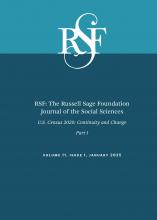Abstract
This article traces the history of census undercount and its importance to civil rights. The Constitution mandates a census and calls for Congress to use the results to apportion seats in Congress and the Electoral College. A substantial undercount in the census will misallocate congressional and electoral college votes. More recently, census-derived statistics are used for the geographic allocation of federal and state funds. This linkage of the census count to the distribution of federal and state funds puts the undercount on the radar for states and municipalities. Closely tied to the undercount and becoming a more central issue to the Census Bureau is the difficulties in reaching hard-to-count populations. Is the Census Bureau up to the task? We end our story with a discussion of Detroit’s experience with the 2020 Census, including its unsuccessful challenge to its housing count.
- © 2025 Russell Sage Foundation. Neidert, Lisa, Reynolds Farley, and Jeffrey Morenoff. 2025. “How Census Undercount Became a Civil Rights Issue and Why It Is Increasingly Important.” RSF: The Russell Sage Foundation Journal of the Social Sciences 11(1): 26–43. https://doi.org/10.7758/RSF.2025.11.1.02. Direct correspondence to: Lisa Neidert, at lisan{at}umich.edu, 909 Northwood Ann Arbor, Michigan 48103, United States; Reynolds Farley, at renf{at}umich.edu, 807 Asa Gray Drive #306 Ann Arbor, Michigan 48105, United States; Jeffrey Morenoff, at morenoff{at}umich.edu, Gerald R. Ford School of Public Policy, University of Michigan, 735 South State Street, Ann Arbor, Michigan 48109, United States.
Open Access Policy: RSF: The Russell Sage Foundation Journal of the Social Sciences is an open access journal. This article is published under a Creative Commons Attribution-NonCommercial-NoDerivs 3.0 Unported License.






